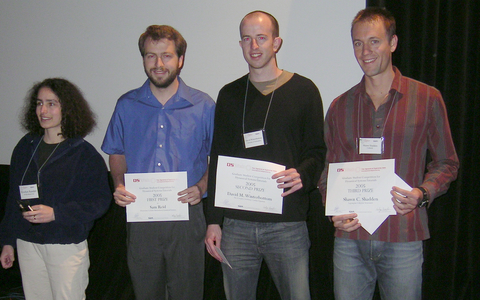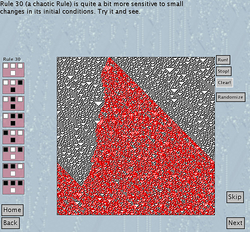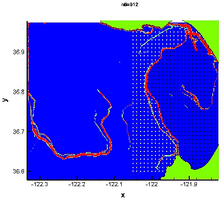
|
DSWeb Tutorials Competition
By Evelyn Sander
George Mason University
|
This spring, DSWeb was pleased to sponsor the first graduate student
competition for dynamical systems tutorials. Robert Devaney, John
Guckenheimer, Jerrold Marsden, Björn Sandstede, and Steven
Strogatz served as judges. Winners and runner-ups received cash
prizes and now appear in the Tutorials
section of DSWeb. The contest was a great success. It gave
students an opportunity and incentive to hone their expository skills
and be judged by leading expositors in dynamical systems. The winners
were recognized at an awards ceremony at the SIAM Dynamical Systems
Meeting in Snowbird, Utah. In addition, the winning entries are a fun,
interesting, and informative set of tutorials which take advantage of
the web as an interactive educational tool. Each would be an
excellent supplement to a dynamical systems or differential equations
course.
 |
| Tutorials Section Chief
Editor Evelyn Sander and contest winners Sam Reid, David Winterbottom,
and Shawn Shadden at the awards ceremony at the SIAM Dynamical Systems
Meeting in Snowbird, Utah. Photo by Bernd
Krauskopf. |
The first prize went to Sam Reid of Department of Computer Science
University of Colorado at Boulder for his entry
Elementary Cellular
Automata as Dynamical Systems. The tutorial teaches dynamical
concepts using cellular automata. It is carefully constructed - a
model of how to teach using the web. Concepts are introduced slowly
and reinforced using teaching tools such as thoughtful quizzes,
detailed help buttons, and illustrative use of color. Any
undergraduate mathematics student would find it a joy to read. Reid
explained "I am currently a student of computer science, but cellular
automata have been a long-time hobby since my days as a physics
major. I really enjoyed working on this tutorial. I am very thankful
to DSWeb for hosting this contest and acknowledging my work."
David Winterbottom of the School of Mathematical Sciences, University
of Nottingham, UK took second place with
The complex
Ginzburg-Landau equation. The tutorial is a comprehensive
introduction to this
famous family of partial differential equations. The many different
behaviors seen - such as stationary patterns, oscillations, waves,
spirals, and turbulence - are described and illustrated using
pictures and movies. Historical background and applications are also
given. Says Winterbottom, "My advisor pointed this contest out to me
since I like to write for the web and use java. It turned out to be a
lot of work, but it was also a lot of fun."
 |
|
 |
| Sam Reid's winning
entry uses interactive Java as a educational tool for explaining the
dynamics of cellular automata. (Click on each figure to link directly
to the contest entry.) |
The second place tutorial by David Winterbottom uses
figures and movies to give a broad explanation of the Complex
Ginzburg-Landau equations. This figure shows a spatiotemporal plot of
defect-mediated turbulence. |
Third prize winner Shawn Shadden, Control and Dynamical Systems,
Caltech, described a dynamical tool for analysis of experimental data
in Lagrangian Coherent
Structures: Analysis of time-dependent dynamical systems using
finite-time Lyapunov exponents. The tutorial gives an in depth
look at the use of finite-time Lyapunov exponents in the study of
systems with arbitrary time dependence. Shadden explains how to use
finite-time Lyapunov exponents in the context of fluid flow to find
time-dependent separatrices known as Lagrangian coherent
structures. Using both images and animations, the theoretical
techniques are illustrated through analysis of oceanographic and
aerodynamic data.
Runner-up Brian Bockelman, Department of Mathematics University of
Nebraska-Lincoln, wrote the tutorial Dynamic Equations on the Sierpinski Gasket. This
comprehensive introduction to harmonic analysis on the Sierpinski
gasket presents an unusual but illuminating point of view for
differentiation. His writing style is refreshingly light, making the
material quite accessible to any mathematical reader. However, the
tutorial is by no means elementary - Bockelman has developed a
sophisticated software package for Sierpinski gasket spline and finite
element methods and illustrates the use of Green's functions,
calculation of bi- and tri-harmonic functions and eigenvalues and
eigenfunctions. Thus readers can use the package for further
experimentation.
Honorable mentions went to Sebastian Marotta, Boston University,
for Mathematica
notebooks for Iterated Function Systems, and Gouhei Tanaka,
Department of Complexity Science and Engineering University of Tokyo,
Japan, for Crisis-induced Intermittency in Coupled Chaotic
Maps.
 |
|
 |
| Shawn Shadden's third
place entry is an in-depth tutorial on finite time Lyapunov exponents
to compute dynamics of real data. This figure is a separatrix for
ocean currents in Monterey Bay, CA. |
Runner-up Brian Bockelman's
Tutorial on harmonic functions on the Sierpinski Gasket, such as the
one shown here. It is a witty self-contained introduction to the
subject with sophisticated interactive computational tools for
experimentation. |
Both the awards ceremony in Snowbird and this article end with the
following invitation: This contest was limited to graduate
students. However, DSWeb encourages Tutorials contributions from all
members of the dynamical systems community. For example, a link from
DSWeb spreads the word about your interactive tutorial. It is also a
good way to share typed lecture notes with the rest of the
community.